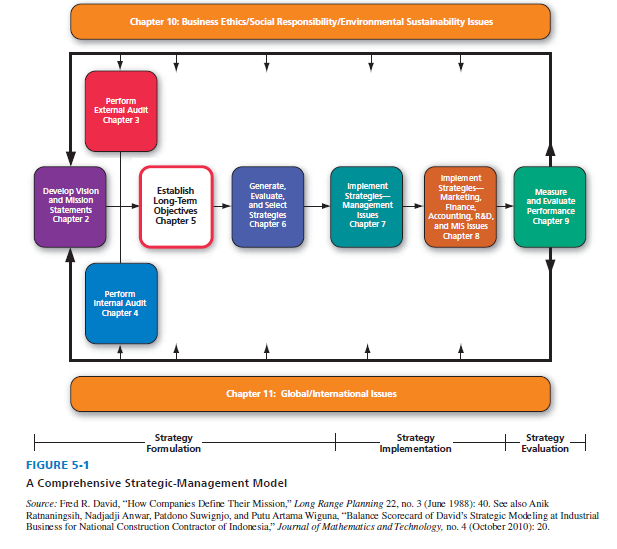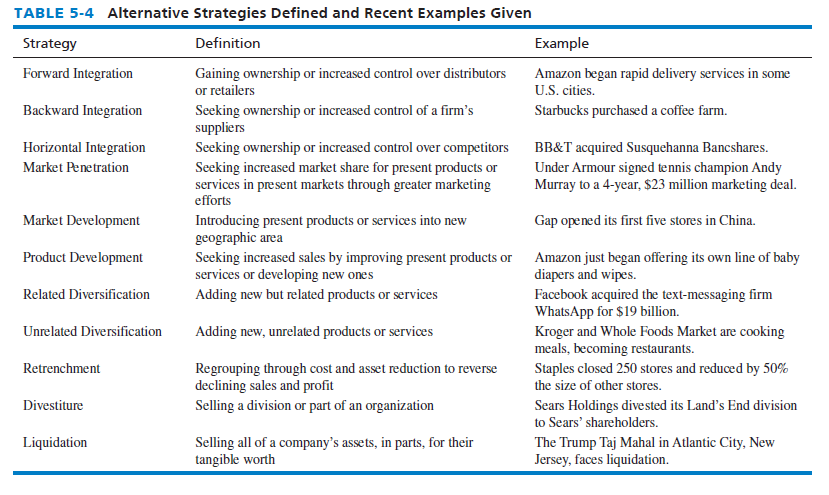The model illustrated in Figure 5-1 provides a conceptual basis for applying strategic management. Defined and exemplified in Table 5-4, alternative strategies that an enterprise could pursue can be categorized into 11 actions: forward integration, backward integration, horizontal integration, market penetration, market development, product development, related diversification, unrelated diversification, retrenchment, divestiture, and liquidation. Each alternative strategy has countless variations. For example, market penetration can include adding salespersons, increasing advertising expenditures, couponing, and using similar actions to increase market share in a given geographic area.

Most organizations simultaneously pursue a combination of two or more strategies, but a combination strategy can be exceptionally risky if carried too far. No organization can afford to pursue all the strategies that might benefit the firm. Difficult decisions must be made. Priorities must be established. Organizations, like individuals, have limited resources. Both organizations and individuals must choose among alternative strategies and avoid excessive indebtedness.
Hansen and Smith explain that strategic planning involves “choices that risk resources and trade-offs that sacrifice opportunity.” In other words, if you have a strategy to go north, then you must buy snowshoes and warm jackets (spend resources) and forgo the opportunity of “faster population growth in southern states.” You cannot have a strategy to go north and then take a step east, south, or west “just to be on the safe side.” Firms spend resources and focus on a finite number of opportunities in pursuing strategies to achieve an uncertain outcome in the future. Strategic planning is much more than a roll of the dice; it is an educated wager based on predictions and hypotheses that are continually tested and refined by knowledge, research, experience, and learning. Survival of the firm oftentimes hinges on an excellent strategic plan.3

Organizations cannot excel in too many things because resources and talents get spread thin and competitors gain advantage. In large, diversified companies, a combination strategy is commonly employed when different divisions pursue different strategies. Also, organizations struggling to survive may simultaneously employ a combination of several defensive strategies, such as divestiture, liquidation, and retrenchment.
Levels of Strategies
Strategy making is not just a task for top executives. Middle- and lower-level managers also must be involved in the strategic-planning process to the extent possible. In large firms, there are actually four levels of strategies: corporate, divisional, functional, and operational—as illustrated in Figure 5-2. However, in small firms, there are three levels of strategies: company, functional, and operational.
The persons primarily responsible for having effective strategies at the various levels include the CEO or business owner at the corporate level; the president or executive vice president at the divisional level; the chief finance officer (CFO), chief information officer (CIO), human resource manager (HRM), chief marketing officer (CMO), and so on at the functional level; and the plant manager, regional sales manager, and so on at the operational level. It is important that all managers at all levels participate and understand the firm’s strategic plan to help ensure coordination, facilitation, and commitment, while avoiding inconsistency, inefficiency, and miscommunication.
Source: David Fred, David Forest (2016), Strategic Management: A Competitive Advantage Approach, Concepts and Cases, Pearson (16th Edition).

Hi there very nice site!! Man .. Excellent .. Superb .. I will bookmark your web site and take the feeds additionally…I am glad to search out so many useful info right here within the submit, we want work out extra techniques on this regard, thanks for sharing.
This is a very good tips especially to those new to blogosphere, brief and accurate information… Thanks for sharing this one. A must read article.